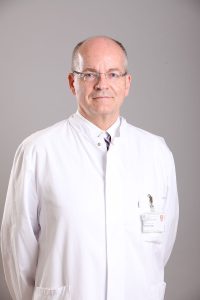The objective is to achieve four individual regional chemo liver sessions (half the liver per session) with Professor Vogle between November and January. In between these sessions, receive as much complementary therapy as possible.
Univ. Prof. Dr. med. Thomas J. Vogl

Transarterial chemoembolization/chemoperfusion; Abdomen Rotation Vom. Puncture of the femoral. Introduction of a 5F lock. Careful positioning of a pigtail catheter. Incorporation of a cobra catheter. 9.88mg mitomycin, 101, 18 mg irinotecan, 50, 2mg cisplatin, 5 ml Lipiodol occlusion, 180 mg EmboCept. Other: 3mg Granisetron, 20mg Dexacortin, 100mg Pethidine
Dr. med. Jürgen Arnhold

Curcumin: Is a substance found in the spice turmeric and has long been used in Asian medicine to treat a variety of maladies. It has antioxidant properties, to decrease swelling and inflammation. Inflammation appears to play a role in cancer.
Shogal; Is a biochemical produced during drying and cooking of ginger roots. It is active against tumour stem cells in concentrations which are harmless for healthy cells. The raw ginger extract can inhibit the proliferation of cancer cells
Resveratrol; A dietary polyphenol derived from grapes, berries, peanuts, and other plant sources. Resveratrol affects all three discrete stages of carcinogenesis (initiation, promotion, and progression) by modulating signal transduction pathways that control cell division and growth, apoptosis, inflammation, angiogenesis, and metastasis.
Photodynamic Therapy: A photosensitizing agent is injected into the bloodstream. The agent is absorbed by cells all over the body but stays in cancer cells longer than it does in normal cells. Approximately 24 to 72 hours after injection. When most of the agent has left normal cells but remains in cancer cells, the tumour is exposed to light. The photosensitizer in the tumour absorbs the light and produces an active form of oxygen that destroys nearby cancer cells.
In addition to directly killing cancer cells, PDT appears to shrink or destroy tumours in two other ways. The photosensitizer can damage blood vessels in the tumour, thereby preventing the cancer from receiving necessary nutrients. PDT also may activate the immune system to attack the tumour cells.
Dr Gerhard Siebenhüner

IPT (Insulin Potentiation Therapy); Normally this therapy is done with a low dose of chemotherapy. However, because Lou still has chemo in her liver from the TACE, this process helps the chemo in her body do its thang.
DCA Infusion: The aim of this drug is to kill off cancer cells, while not harming healthy cells. DCA turns on natural apoptosis (cell death) in the cancerous cells. It also blocks the process by which glucose is used by cancer cells, thus removing their energy source and starving them. Without blocking the glucose of healthy cells.
High Dose C: Vitamin C breaks down to generate hydrogen peroxide, which can damage tissue and DNA. The new study shows that tumor cells with low levels of catalase enzyme activity are much less capable of removing hydrogen peroxide than normal cells, and are more susceptible to damage and death when they are exposed to high doses of vitamin C.
Artesunat Infusion: A substance from the annual mugwort, has a destructive effect on rapidly growing cancer cells. Tumour cells have much higher iron concentrations than healthy cells due to their extremely accelerated rate of cell division. Artesunate gets into the heavily iron-loaded cancer cells, spontaneously large amounts of so-called free radicals are released, which damage the cancer cells and finally destroy. Recent studies show that Artesunate interferes with the neovascularization of the tumour. In this way, the tumour cells can be cut off from the blood supply and starved, this reduces the possibility of metastasis formation.
Extracorporeal Regional Hyperthermia EHY-RG: This involves artificial heating of the affected areas of the body to temperatures above 40.1 degrees Celsius. This is done by irradiation of electromagnetic waves. The body surface is protected by water cooling of the overlying irridation head. Heat can harm or kill cancer cells by damaging proteins and structures within the cells. Heat also damages blood vessels inside of tumours and causes less blood flow to the tumour, which can help slow its growth.
The above list of infusions and hyperthermia is alternatively managed by Arnhold and Siebenhüner and worked around Vogl’s TACE
- Note added in December: We were not able to continue with all of the above-intended treatments. Lou’s liver is not healthy enough. We have only been doing a reduced amount of infusions to aid recovery.



